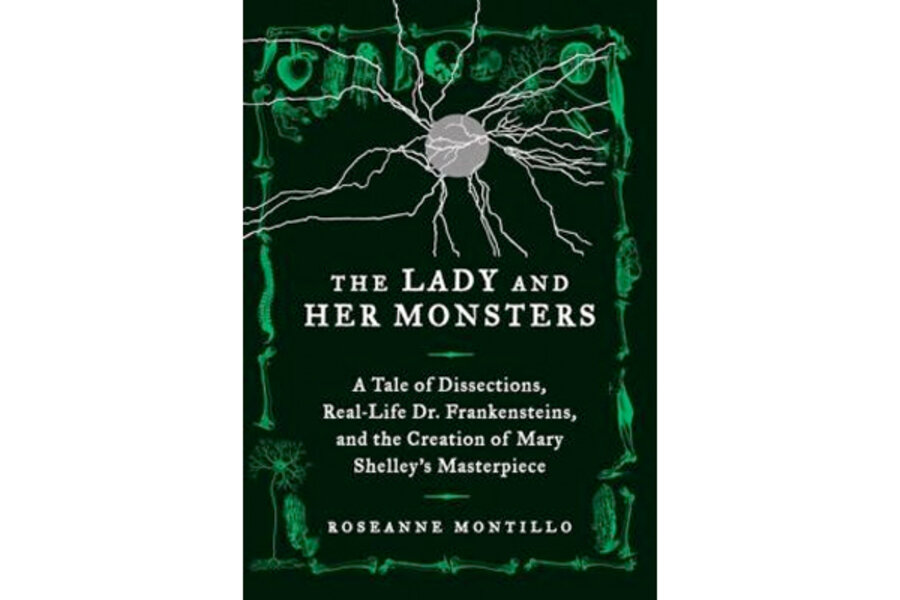Roseanne Montillo discusses 'The Lady and Her Monsters,' her book about Mary Shelley
Loading...
Like many others with limited maturity levels, I've been utterly corrupted by Mel Brooks.
Bring up the word "Frankenstein" and I don't think of Mary Shelley or even Boris Karloff. No, unfortunate people like me immediately fall into a reverie of jokes from a certain 1970s movie: "Blücher!" (whinny), "Would you like a roll in zee hay?," and, of course, "What hump?"
Never mind all that (even poor Abby Normal). Or the other Frankenstein movies, the Halloween costumes, and "The Munsters." Turns out they miss much of the gist of the original 1818 novel.
Frankenstein is the scientist, not the monster. His creation is smart and eloquent, far from a grunting ogre. Beyond that, the whole story – as imagined by an extraordinary young woman – explores deep questions about humanity, death, and the limits of science.
Emerson College literature professor Roseanne Montillo explores a world of grave-robbing, fantastic, scientific advances and scandalous writerly behavior in her new book "The Lady and Her Monsters: A Tale of Dissections, Real-Life Dr. Frankensteins, and the Creation of Mary Shelley's Masterpiece."
In an interview, Montillo talks about science without boundaries, a monster with a brain, and the "Frankenstein" quandaries that still resonate after almost two centuries.
Q: These days, scientists would be laughed out of the laboratory if they tried to study bringing people back from death.
But, as you write, respectable scientists of 200 years ago loved to explore the prospect of reanimating the dead. How were things different back then in terms of acceptable scientific pursuits?
A: There was a great demand after the French Revolution – maybe something can be done to bring all of these young people back. A lot of women were left without husbands, fathers without young ones. Maybe something can be done for all these people who are sad, grief-stricken, and upset.
There was also the idea of a financial gain. If you could bring people back, they could go back to work.
Q: According to Christianity, dead people don't return to earth in a human form. How did the idea of reanimation challenge people's faith?
A: You're taking God completely out of the equation if you believe you can bring someone back. If you're assuming you can do it yourself, like Frankenstein, what do you need God for?
For the religious individuals, this was a no-no right off the bat.
Q: What about the wishes of the dead people themselves, like the many criminals who were executed at the gallows and then experimented upon?
A: Maybe these people didn't want to come back. Maybe they'd gone to heaven and it was a good place, or they went to hell and it was where they belonged.
Maybe they didn't want to come back or shouldn't come back at all. No one took this into consideration.
Q: Did the book explore these issues?
A: "Frankenstein" was one of the earliest books to ask these questions.
At the onset, it seems very much a plain horror story. But once you read on inside, it asks a lot of deep moral questions. People didn't have the answers for them then, and we still don't today.
Q: How is our popular view of Frankenstein and his monster different from the original portrait that Mary Shelley created?
A: The pop-culture view of Frankenstein's monster is focused on his freakiness: the creature is a lump of bones.
In the book, the creature was meant to be a moral compass. He commits horrible deeds, but he's also very eloquent. He's an intelligent being, he speaks very clearly. He tries to be nice and makes a conscious choice to move to evil. One could debate whether he's even smarter than Victor Frankenstein himself.
Most of the movies miss that. He grumbles, he's green, he's got those outstretched hands. You know what he's going to do if you come in contact with him.
Q: Did Mary Shelley create the first "mad scientist" of fiction?
A: She really did.
One could argue whether he was truly mad. I'm not sure, but he is eccentric. He wants to know more, he's into the pursuit of knowledge, he is curious and intelligent. The book tells you right away that he wants to know the secrets of heaven and earth.
He did achieve his goal to give life to a creature. But he missed the mark and didn't live up to his responsibilities. I think he became a little bit mad afterward.
Q: How does the book fit into the early development of what we now know as the genres of science fiction and horror fiction?
A: It was probably the first science-fiction book. She led the way for everyone who came after her.
Different bookstores have different ways of labeling it. It can be science fiction or horror. Many bookstores place it in feminist fiction as well, which is odd to me.
Q: What message is Mary Shelley sending that's still relevant today?
A: Mary Shelley wrote "Frankenstein" as a warning to society. At that time, people had ambition and wanted to push those lines and see how far they could go.
But where is that boundary? Science wants to achieve its goals, but how do you know when too much is too much? Is there a line that shouldn't be crossed?
I'm not quite certain there is. But you do have to take responsibility for your creations since consequences can be quite dire, as Victor Frankenstein found out.
Q: So she's giving a warning to scientists?
A: It is a warning, but I don't think they will see it as that.
If anything, Mary Shelley had an opposite effect: People see this as something that could be done.
Randy Dotinga is a Monitor contributor.





